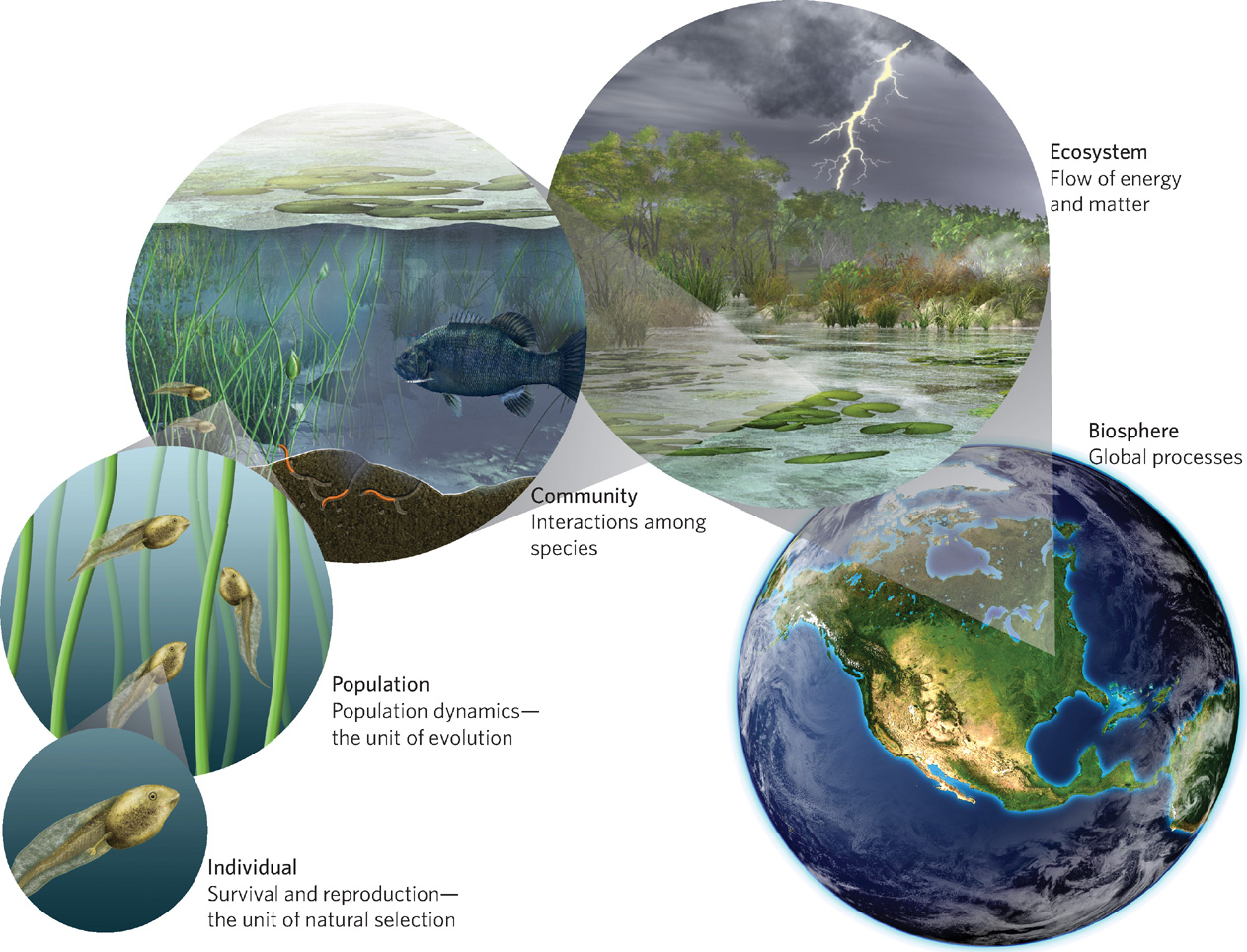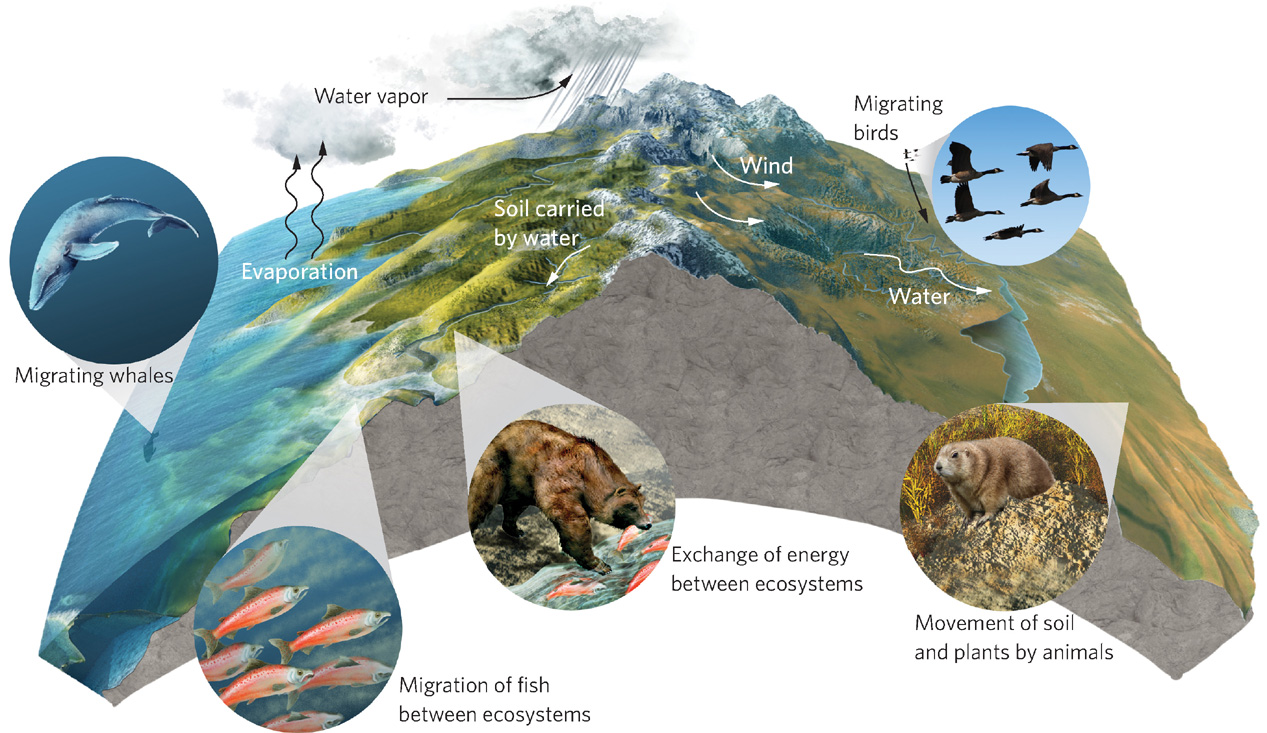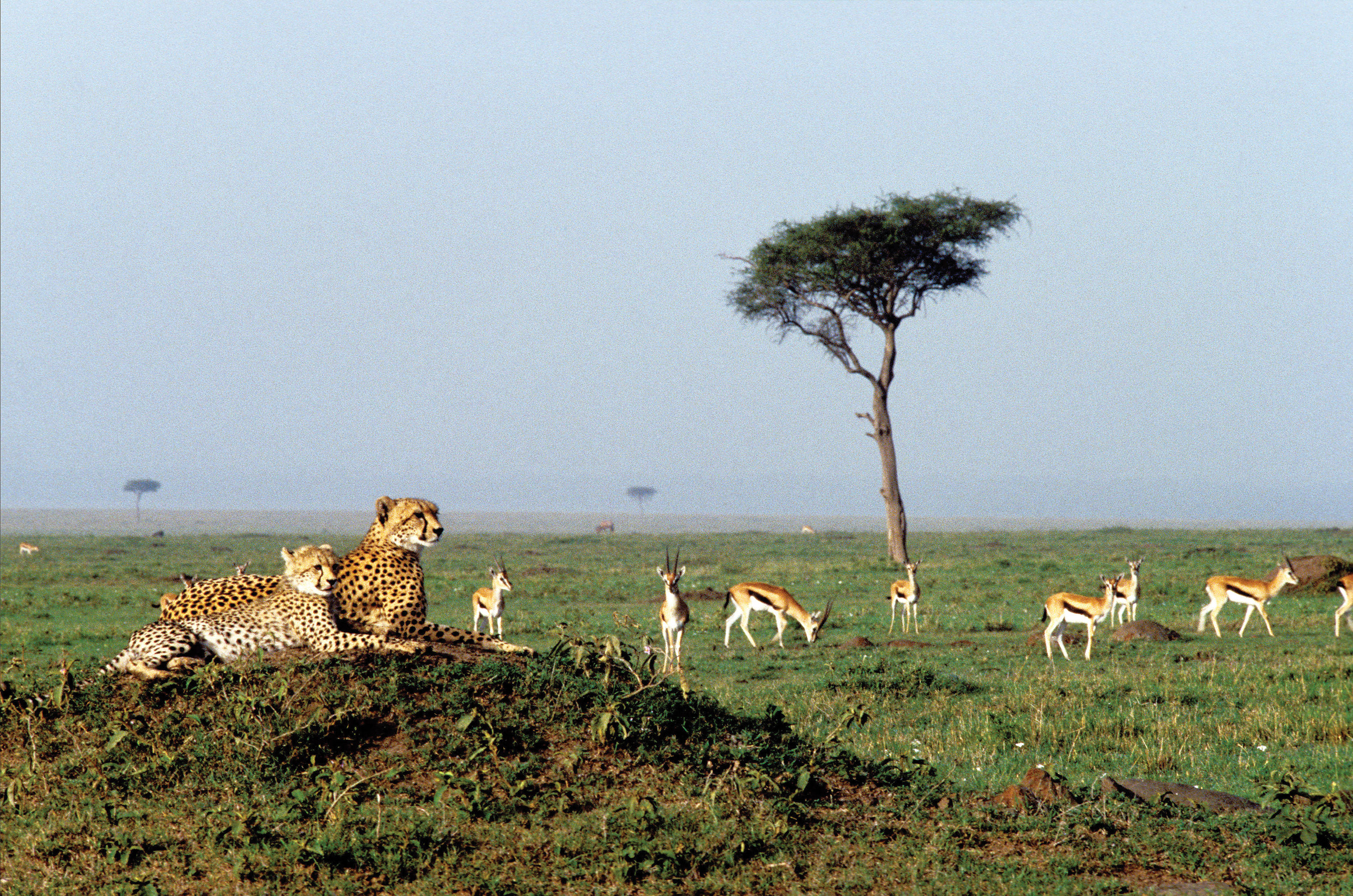Ecological systems exist in a hierarchy of organization
An ecological system may be an individual, a population, a community, an ecosystem, or the entire biosphere. As you can see in Figure 1.1, each ecological system is a subset of the next larger one, so the different types of ecological systems form a hierarchy. In this section we will examine the individual components of ecological systems, and how we study ecology at different levels in the ecological hierarchy.

Individuals
Individual A living being; the most fundamental unit of ecology.
An individual is a living being—the most fundamental unit of ecology. Although smaller units in biology exist—for example an organ, a cell, or a macromolecule—none of them has a separate life in the environment. Every individual has a membrane or other covering across which it exchanges energy and materials with its environment. This boundary separates the internal processes and structures of the ecological system from the external resources and conditions of the environment. In the course of its life, an individual transforms energy and processes materials. To accomplish this, it must acquire energy and nutrients from its surroundings and rid itself of unwanted waste products. This process alters the conditions of the environment and affects the resources available for other organisms. It also contributes to the movement of energy and chemical elements.
Populations and Species
Species Historically defined as a group of organisms that naturally interbreed with each other and produce fertile offspring. Current research demonstrates that no single definition can be applied to all organisms.
Scientists assign organisms to particular species. Historically, the term species was defined as a group of organisms that naturally interbred with each other and produced fertile offspring. Over time, scientists have realized that this definition does not fit all species because no single definition can apply to all organisms. For example, some species of salamanders are all female and only produce daughters, which are clones of their mothers. In this case, individuals do not interbreed, but we consider these individuals to be of the same species because they are genetically very similar to each other. In addition, some organisms that we consider distinct species can interbreed. In cases where this interbreeding occurs, we cannot use reproductive isolation to draw the line between species.
4
Defining a species becomes even more complicated when we consider organisms such as bacteria, which are prokaryotes—that is to say, individuals consisting of a simple, single cell without a nucleus or any other membrane-bound organelles. Scientists increasingly appreciate that prokaryotic organisms can transfer bits of their DNA to other bacteria that are not closely related, a process known as horizontal gene transfer. This can happen in a number of ways: when a bacterium engulfs genetic material from the environment, when two bacteria come into contact and exchange genetic material, or when a virus transfers genetic material between two bacteria. Such cases make it difficult to group prokaryotic organisms into distinct species. Despite these difficulties, the term species has still proven useful to ecologists.
Population The individuals of the same species living in a particular area.
A population consists of individuals of the same species living in a particular area. For example, we might talk about a population of catfish living in a pond, a population of wolves living in Canada, or a population of tubeworms living near a hydrothermal vent on the ocean floor. The boundaries that determine a population can be natural, for example where a continent meets the ocean. Alternatively, a population might be defined by another criterion such as a political boundary. For example, a scientist might want to study the population of bald eagles (Haliaeetus leucocephalus) that resides in Pennsylvania, whereas biologists of the U.S. Fish and Wildlife Service might want to study the bald eagle population of the entire United States.
Populations have five distinct properties that are not exhibited by individuals: geographic range, abundance, density, change in size, and composition. The geographic range of a population—also known as its distribution—is the extent of land or water within which a population lives. For example, the geographic range of the North American grizzly bear (Ursus arctos) includes western Canada, Alaska, Montana, and Wyoming. The abundance of a population refers to the total number of individuals. The density of a population refers to the number of individuals per unit of area. For instance, we might count the grizzly bears in an area and determine that there is 1 bear/100 km2. The change in size of a population refers to increases and decreases in the number of individuals in an area. Finally, composition of a population describes the makeup of the population in terms of gender, age, or genetics. For example, we can ask what proportion of the grizzly population is male versus female, or juvenile versus adult.
5
Communities
Community All populations of species living together in a particular area.
At the next level of the ecological hierarchy, we identify an ecological community, which is composed of all populations of species living together in a particular area. The populations in a community interact with each other in various ways. Some species eat other species while others, for example bees and the plants they pollinate, have cooperative relationships that benefit both parties. These types of interactions influence the number of individuals in each population. A community may cover large areas, such as a large forest, or may be enclosed within a very small area, such as the community of tiny organisms that live in the digestive systems of animals, or in the tiny amount of water found in tree holes. In practical terms, ecologists who study communities do not study every organism in the community. Instead, they generally study a subset of the organisms in the community, such as the trees, the insects, or the birds, as well as the interactions between certain groups of organisms.
The boundaries that define a community are not always rigid. For example, if you were to examine the species of plants and animals that live at the base of a mountain in Colorado, you would find that most differ from the species of plants and animals that live at the top of this mountain. That is, the base and the peak appear to have distinctly different communities. However, if you were to walk up the mountain, you would notice that some species of trees, such as Douglas firs (Pseudotsuga menziesii), are abundant at the beginning of your hike and then gradually dwindle as you move higher. Other species, such as subalpine firs (Abies lasiocarpa), begin to take their place as the number of Douglas firs declines. In other words, the boundaries of the upper and lower forest communities are not distinct. Because of this, scientists must often decide on the boundaries of a community they want to study. For instance, an ecologist might decide to study the community of plants and animals on a large desert ranch in New Mexico, or the community of aquatic organisms that lives along a designated stretch of coastline in California. In these cases, no distinct boundary separates the studied community from the area that surrounds it.
Ecosystems
Ecosystem One or more communities of living organisms interacting with their nonliving physical and chemical environments.
From communities we move on to ecosystems. An ecosystem is composed of one or more communities of living organisms interacting with their nonliving physical and chemical environments, which include water, air, temperature, sunlight, and nutrients. Ecosystems are complex ecological systems that can include many thousands of different species living under a great variety of conditions. For example, we may speak of the Great Lakes ecosystem or the Great Plains ecosystem.
At the ecosystem level, we typically focus on the movement of energy and matter between physical and biological components of the ecosystem. Most energy that flows through ecosystems originates with sunlight and eventually escapes Earth as radiated heat. In contrast, matter cycles within and between ecosystems. With the exception of places such as deep-sea vents where energy is acquired through chemosynthesis, the energy for most ecosystems comes from the Sun and is converted to organic compounds by photosynthetic plants and algae. These organisms can then be eaten by herbivores—animals that eat plants—which are in turn eaten by carnivores—animals that eat other animals. In addition, dead organisms and their waste products can be consumed by detritivores, which themselves can be consumed by other animals. In all of these cases, each step results in some of the energy originally assimilated from sunlight being converted into growth or reproduction of consumers; the remainder of the energy is lost to the surroundings as heat, and is eventually radiated back into space.
In contrast to the movement of energy, the movement of matter largely cycles within an ecosystem. When considering matter in an ecosystem, we often look at the most common elements that organisms use, such as carbon, oxygen, hydrogen, nitrogen, and phosphorus. These elements comprise a major portion of the most important compounds for living organisms and include water, carbohydrates, proteins, and DNA. These elements can be held in many different places, or pools, on Earth, including in living organisms, and in the atmosphere, water, and rocks. The movement of these elements among these pools is known as the flow of matter. For instance, many nutrients that are in the soil are taken up by plants, and these plants are consumed by animals. The nutrients exist in an animal’s tissues, and many leave as excreted waste. When the animal dies, the nutrients in its tissues are returned to the soil, thereby completing the cycling of nutrients.
6
The boundaries of ecosystems, like those of populations and communities, are often not distinct. Scientists generally distinguish ecosystems by their relative isolation with respect to flows of energy and materials, but, in reality, few ecosystems are completely isolated. Even aquatic and terrestrial ecosystems exchange materials and energy by runoff from the land and the harvesting of aquatic organisms by terrestrial consumers, as when bears capture salmon on their upstream spawning runs.
The Biosphere
Biosphere All of the ecosystems on Earth.
At the highest level of the ecological hierarchy is the biosphere, which includes all of the ecosystems on Earth. As Figure 1.2 illustrates, distant ecosystems are linked together by exchanges of energy and nutrients carried by currents of wind and water and by the movements of organisms, such as migrating whales, birds, and fish. Such movement connects terrestrial, freshwater, and marine ecosystems by carrying soil, nutrients, and organisms.

The biosphere is the ultimate ecological system. All transformations of the biosphere are internal, with two exceptions: the energy that enters from the Sun, and the energy that is lost to space. The biosphere holds practically all materials that it has ever had, and retains whatever waste materials we generate.
Studying Ecology at Different Levels of Organization
Each level in the hierarchy of ecological systems is distinguished by unique structures and processes. As a result, ecologists have developed different approaches for exploring these levels and for answering the questions that arise. The five approaches to studying ecology match the different levels of hierarchy: the individual approach, the population approach, the community approach, the ecosystem approach, and the biosphere approach.
Individual approach An approach to ecology that emphasizes the way in which an individual’s morphology, physiology, and behavior enable it to survive in its environment.
The individual approach to ecology emphasizes the way in which an individual’s morphology (the size and shape of its body), physiology, and behavior enable it to survive in its environment. This approach also seeks to understand why an organism lives in some environments but not in others. For example, an ecologist studying plants at the organism level might ask why trees are dominant in warm, moist environments, while shrubs with small, tough leaves are dominant in environments with cool, wet winters and hot, dry summers.
7
Adaptation A characteristic of an organism that makes it well-suited to its environment.
Ecologists who use the individual approach are often interested in adaptations—the characteristics of an organism that make it well-suited to its environment. For example, desert animals have enhanced kidney function, which helps them to conserve water. The cryptic coloration of many animals helps them avoid detection by predators. Flowers are shaped and scented to attract certain kinds of pollinators. Adaptations are the result of evolutionary change through the process of natural selection, which we will consider later in this chapter.
Population approach An approach to ecology that emphasizes variation over time and space in the number of individuals, the density of individuals, and the composition of individuals.
The population approach to ecology examines variation over time and space in the number of individuals, the density of individuals, and the composition of individuals, which includes the sex ratio, the distribution of individuals among different age classes, and the genetic makeup of a population. Changes in the number or density of individuals can reflect the balance of births and deaths within a population, as well as immigration and emigration of individuals from a local population. This can be influenced by a number of factors, including interactions with other species and the physical conditions of the environment, such as temperature or the availability of water. In the process of evolution, genetic mutations may alter birth and death rates, genetically distinct types of individuals may become common within a population, and the overall genetic makeup of the population may change. Because other species might serve as food, pathogens, or predators, interactions among species can also influence the births and deaths of individuals within a population.
The community approach to ecology is concerned with understanding the diversity and relative abundances of different kinds of organisms living together in the same place. The community approach focuses on interactions between populations, which can either promote or limit the coexistence of species (Figure 1.3). For example, in studying the Serengeti Plains of Africa, an ecologist taking the community approach might ask how the presence of zebras, which consume grasses, might affect the abundance of other species, such as gazelles, that also consume the grasses.

Community approach An approach to ecology that emphasizes the diversity and relative abundances of different kinds of organisms living together in the same place.
Ecosystem approach An approach to ecology that emphasizes the storage and transfer of energy and matter, including the various chemical elements essential to life.
The ecosystem approach to ecology describes the storage and transfer of energy and matter, including the various chemical elements essential to life, such as oxygen, carbon, nitrogen, phosphorus, and sulfur. These movements of energy and matter occur through the activities of organisms and through the physical and chemical transformations that occur in the soil, atmosphere, and water.
Biosphere approach An approach to ecology concerned with the largest scale in the hierarchy of ecological systems, including movements of air and water—and the energy and chemical elements they contain—over Earth’s surface.
The biosphere approach to ecology is concerned with the largest scale in the hierarchy of ecological systems. This approach tackles the movements of air and water—and the energy and chemical elements they contain—over Earth’s surface. Ocean currents and winds carry the heat and moisture that define the climates at each location on Earth, which in turn govern the distributions of organisms, the dynamics of populations, the composition of communities, and the productivity of ecosystems.
We have described these five approaches as distinct. However, most ecologists use multiple approaches to study the natural world. A scientist who wants to understand how an ecosystem will respond to a drought, for example, will likely want to know how individual plants and animals respond to a lack of water, how these individual responses affect the populations of plants and animals, how a change in the populations might affect interactions among species, and how a change in species interactions might affect a change in the flow of energy and matter.
8